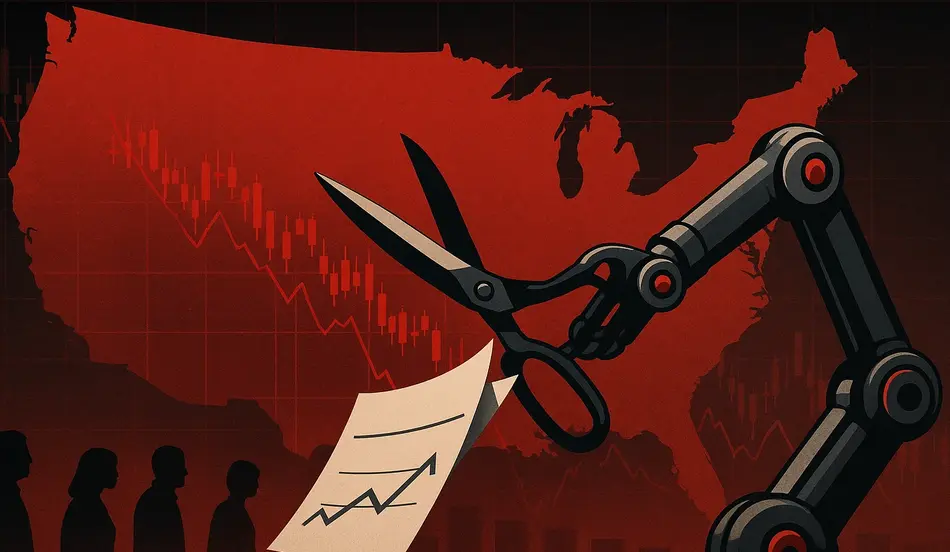The Worst Jobs Report Since 2020
The 2025 US Jobs Report landed with the force of an economic earthquake. As of early August, 806,000 Americans have already lost their jobs this year — more than the total for all of 2024. July alone saw 62,000 layoffs, while government figures that once painted a picture of robust job growth were suddenly revised downward by 258,000 jobs overnight.
These revisions stripped away months of “booming growth” narratives and revealed something more alarming: an economy showing signs of strain from multiple fronts — political decisions, corporate restructuring, and a rapid wave of AI-driven automation.
According to the Bureau of Labor Statistics, non-farm payrolls in July rose by only 73,000, far below the 115,000 jobs economists had forecast. This marked the weakest pace of the year and one of the softest readings since the pandemic recovery.
Downward Revisions Shake Confidence
The revisions were not minor bookkeeping errors — they were historic corrections. June’s jobs number was slashed from 147,000 to just 14,000, and May dropped to 19,000.
This three-month stretch — May, June, and July — now stands among the weakest job-growth periods since early 2020. The unemployment rate ticked up from 4.1% to 4.2%, marking the fourth time it’s hit that level this year.
Perhaps most worrying is the labor force participation rate, which slipped to 62.2%, the lowest since late 2022. This suggests not only job losses but a growing number of Americans simply giving up on finding work.
Government Job Cuts Drive the Numbers
A large part of the bleak headline can be traced to one source: federal layoffs. Nearly 300,000 government jobs have been cut in 2025, accounting for more than a third of total layoffs so far this year.
The Trump administration has defended these cuts as a necessary step to reduce bureaucracy and “right-size” government agencies. Critics argue the opposite — that the layoffs are destabilizing communities and stripping away essential services.
One of the hardest-hit departments was the Department of Veterans Affairs, which shed 17,000 jobs this year alone.
The AI Factor: Layoffs in a Profitable Economy
While government downsizing explains part of the picture, another trend is reshaping the 2025 labor market: automation. More than 20,000 jobs have been eliminated this year specifically because of AI adoption — not because companies were failing, but because they found cheaper, faster ways to operate.
Tech giants led the charge:
- Microsoft cut 9,100 jobs despite posting record profits.
- Intel slashed 24,000 positions, a quarter of its workforce.
- Tata Consultancy Services (TCS) eliminated 12,000 roles under its “future-ready” restructuring plan.
Middle management and entry-level positions, once considered safe, are being erased, with the gains flowing to corporate executives through multimillion-dollar efficiency bonuses.
Political Spin on a Fragile Economy
The 2025 US Jobs Report became an instant talking point for both political camps.
- Conservative media framed the data as proof that overregulation, tariffs, and inefficiency under previous administrations had bloated government and stifled growth. They defended layoffs as “cleaning house.”
- Liberal media called it a “normal economic adjustment,” arguing companies were “rightsizing” for sustainable growth. They pointed to historically low unemployment compared to past recessions.
Both narratives leave out the human cost: tens of thousands of Americans losing homes, healthcare, and stability.
Market Fallout
Wall Street, typically indifferent to layoffs, reacted sharply. The S&P 500 fell 1.7%, the NASDAQ dropped 2.3%, and the Dow Jones Industrial Average plunged 600 points within hours of the report.
Bond yields also tumbled, with the 10-year Treasury yield falling from 4.39% to 4.32% in a single session. Investors are now pricing in an 80% chance of emergency interest rate cuts by the Federal Reserve — a stark shift from its “steady rates” stance just weeks ago.
Driving Through the Layoff Storm? Find Talent That Stays
Over 800K jobs gone in 2025—and AI, automation, and panic are reshaping the market. WhatJobs helps you post smart, resilient hiring strategies now.
Post a Job Now →The Sectors Struggling the Most
Manufacturing
Once touted as a beneficiary of new trade policies, manufacturing shed 11,000 jobs in July alone. Tariffs and import restrictions have led to idle factories, higher raw material costs, and layoffs.
Construction
Construction gained just 2,000 jobs, with many roles going unfilled due to stricter immigration enforcement and rising labor costs. Wages are climbing, but activity is slowing — a sign that projects are stalling.
Retail
Retail employment rose modestly by 15,000 jobs, but the sector remains vulnerable to tariffs, inflation, and online competition. Smaller chains are closing stores at an accelerating pace.
The Bigger Picture: A System That’s Failing Workers
Both corporate and government leaders are quick to assign blame — but slow to offer solutions. Corporate boards reward executives for cutting headcount, while government agencies revise statistics in ways that mask economic distress.
For workers, the message is clear: the system won’t protect you.
The best defense is to build skills that AI cannot replace, diversify income streams, and maintain your own safety net.
FAQ – 2025 US Jobs Report
Q1: What is the 2025 US Jobs Report and why is it important?
The 2025 US Jobs Report is the monthly employment summary from the Bureau of Labor Statistics. It tracks job creation, unemployment, and labor participation — key indicators of economic health.
Q2: How many jobs were lost in the 2025 US Jobs Report?
So far in 2025, 806,000 jobs have been lost, with July’s weak numbers and downward revisions making it the worst report since 2020.
Q3: How is AI affecting the 2025 US Jobs Report?
AI adoption has led to over 20,000 layoffs this year, particularly in tech and middle management, as companies automate roles to cut costs.
Q4: What does the 2025 US Jobs Report mean for interest rates?
The weak jobs data has increased the likelihood of Federal Reserve rate cuts, with markets now pricing in an 80% chance of a September reduction.




